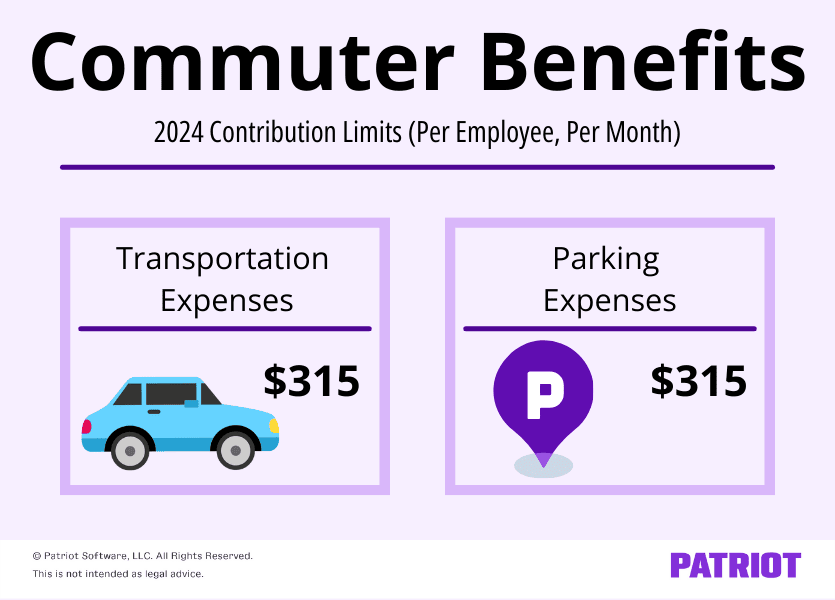Most employees expect certain workplace benefits, such as health insurance or retirement plans. But coming up with unique and appealing perks, like commuter benefits, can further your chances of attracting and retaining top talent.
Commuter benefits aren’t just popular in big cities with prevalent public transportation systems. Any employer can give employees the gift of a commuter tax benefit. Learn more about offering commuter benefits below.
What are commuter benefits?
Commuter benefits are fringe benefits that cover an employee’s transportation-related expenses with pre-tax dollars. Transportation benefits are exempt from income tax withholding, Social Security and Medicare (FICA) taxes, and federal unemployment tax. Employees can use the funds on qualifying expenses, such as public transportation and parking fees.
Offering these benefits decreases employee transportation costs and encourages your workforce to use public transportation, which is especially helpful in congested cities.
Employers and employees can contribute to an employee’s commuter benefits plan. However, your combined contribution must be below the IRS contribution limits, explained later.
Qualified transportation fringe benefits
Employees can use funds to cover transportation expenses and parking expenses.
Transportation expenses: Employees can use their commuter benefit funds to buy transit passes (e.g., passes, tokens, vouchers, etc.) for public transportation. Public transportation includes buses, trains, subways, ferries, or highway vehicles with at least six passenger seats.
Parking expenses: Commuter benefit funds can also go towards parking expenses. Employees can use pre-tax dollars to pay for parking at or near work. Employees can also use funds to pay for parking on or near mass transit premises.
Not all transportation-related expenses are included under commuter benefits. For example, an employee can’t use transit benefit funds to pay for things like gas or car insurance.
IRS contribution limits
The IRS sets contribution limits for both transportation expenses and parking expenses. For 2024, both limits are the same:
- $315 per employee per month for transportation expenses
- $315 per employee per month for parking expenses
These 2024 limits are each up $15 from the 2023 transportation expense and parking expense limit of $300. Again, you and your employee’s combined contributions can’t exceed $315 per month in 2024. However, your employee can elect to enroll in both commuter benefit plans (transportation and parking), if applicable.
Prior to the Tax Cut and Jobs Act of 2017, employees could also use pre-tax dollars to cover up to $20 per month for biking-related expenses. Employees can no longer use commuter benefits for biking-related expenses.

Are employers required to offer commuter benefits?
In most cities, offering commuter benefits to employees is your decision.
But some cities, such as San Francisco, New York City, and Washington D.C., require you to offer transit benefits if you employ a certain number of full-time employees.
If you must offer commuter benefits, talk with your local transit authorities. They can help you set up and administer your commuter benefits program.
Commuter benefits and tax savings
Because commuter benefits are pre-tax deductions, they can reduce the amount your employees pay in payroll and income taxes. When employees contribute to their commuter benefits plan, they owe less in federal income, Medicare, and Social Security taxes.
Offering commuter benefits provides tax savings for employers, too. Social Security and Medicare taxes are employer and employee taxes, meaning you and the employee need to contribute a matching 7.65% of the employee’s wages. When an employee owes less in Social Security and Medicare taxes, you owe less too.
Let’s say an employee earns gross wages of $2,000 per month. Their FICA liability is $153 per month ($2,000 X 0.0765). And, your FICA liability is $153 per month for that employee.
Now let’s say the employee contributes $200 a month to their commuter benefits plan. Because their taxable wages are now $1,800 ($2,000 – $200), you and the employee will only owe $137.70 each.
This reduces your FICA tax liability for that employee by $183.60 per year [($153 – $137.70) X 12).
If you have more than one employee, your year-end FICA tax savings can add up.
Transit deduction for employers
In the past, businesses have been able to claim a federal income tax deduction on the amount they contributed to the commuter benefits program.
However, the Tax Cut and Jobs Act of 2017 eliminated the transit deduction for employers. You can no longer deduct commuter benefit contributions.
Although you cannot claim a transit deduction, you can still enjoy the payroll tax savings that come with offering commuter benefits.
Setting up a commuter benefits program
If you decide to offer a commuter benefits program, or if your business is located in a city that requires it, you need to know your employer responsibilities.
You can use a third-party administrator to set up your program. Generally, you will need to pay a fee per employee. Or, you may be able to create and manage your account through your local transit agency.
After you set up the program, employees must enroll to receive benefits. Educate your employees on the program and thoroughly discuss the program rules. Make information accessible on how they can enroll, what the funds can be used for, how much they can contribute, and whether you are also contributing to their plans.
Employees need to tell you how much they will contribute to their plan. Remember, you and your employee can only contribute up to a combined total of $315 per program per month.
When employees enroll, you need to adjust your payroll. If you are using payroll software, enter the employee’s contribution amounts as a pre-tax deduction. That way, you can withhold the correct amount of taxes, pay the employee, and add their contribution to their commuter benefits plan.
Looking to simplify how you run payroll? Patriot’s online payroll services provide an affordable, accurate, and reliable option for managing payroll. Our online software is made for busy small business owners. Get your free trial today!
This article has been updated from its original publication date of September 12, 2018.
This is not intended as legal advice; for more information, please click here.




